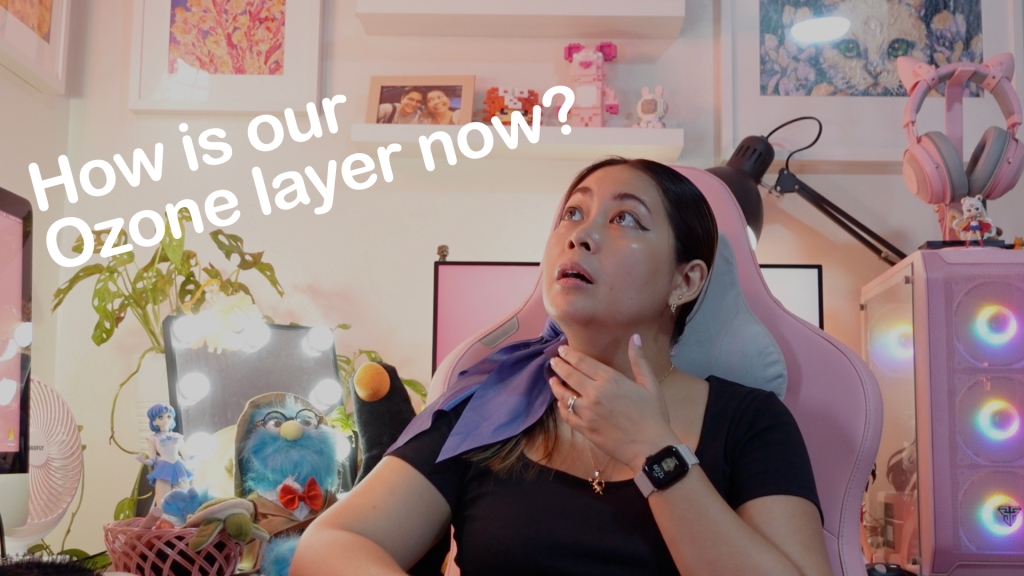Hello Science Fans!
When was the last time you heard about the ozone layer?
The ozone layer is like Earth’s sunscreen. It’s a layer of gas high up in the atmosphere that helps protect us from the sun’s harmful ultraviolet (UV) rays. This layer of ozone molecules absorbs a lot of the UV radiation, preventing most of it from reaching the surface of the Earth. Without the ozone layer, we could get too much UV radiation, which can cause sunburns, skin cancer, and other problems for both humans and the environment.
Sounds important right? But what has been happening to it lately? And why should we be concerned?
Find out the answers to these questions by reading this article or watching our video below:
Before I answer these questions using science, let me first say hi to our new viewers.
My name is Chona and I’m your resident Filipina scientist.
I’m a researcher who loves studying the environment and my dream is for us to develop sustainable habits to be able to live on Earth without damaging it.
I’m a teacher who handles subjects like Ecology, where we love to show our students the beauty of nature.
And SHE-ensya is my science communication channel where I try to share how taking care of the environment is not necessarily difficult.
So, what’s the ‘happs’ with the ozone layer?
For many years, the ozone layer has been experiencing a problem called “ozone depletion.” This means that the amount of ozone in the stratosphere, where the ozone layer is located, has been decreasing. The main cause of this depletion has been the release of certain human-made chemicals called “chlorofluorocarbons” (CFCs) and similar substances into the atmosphere.
These chemicals were commonly used in things like aerosol sprays, refrigerants, and foam insulation. When released into the air, they can rise up to the stratosphere, where they are broken down by sunlight. This process releases chlorine and bromine atoms, which then react with ozone molecules, breaking them apart and reducing the ozone’s protective abilities.
If the ozone layer were to be completely destroyed, the consequences would be quite severe for both human health and the environment.
Without the ozone layer to absorb and filter out a significant portion of the sun’s ultraviolet (UV) radiation, much more UV radiation would reach the Earth’s surface. This could lead to higher rates of skin cancer, cataracts, and other health problems in humans. Increased UV radiation could weaken immune systems in both humans and animals, making us more susceptible to diseases. The increased UV radiation could have an impact on air quality by altering the chemical reactions that occur in the atmosphere, which might affect pollution levels and respiratory health. And since plants are also sensitive to increased UV radiation, elevated UV levels could damage crops and reduce agricultural yields, potentially leading to food shortages.
Increased UV radiation can affect aquatic ecosystems, damaging phytoplankton and other organisms that form the base of the food chain. This could lead to disruptions in marine food webs and impact fisheries. From the sea to the sky, changes in the ozone layer can influence the atmosphere’s temperature and circulation patterns. A severely depleted ozone layer might have complex effects on regional and global climate systems. And at the end of the day, the ozone layer plays a role in absorbing some of the sun’s energy, so its depletion could contribute to warming in the stratosphere.
The hole in the ozone layer, most notably over Antarctica, has been a significant concern. The thinning of the ozone layer in this area was largely due to the presence of the harmful chemicals I described before. However, since the 1980s, international efforts like the Montreal Protocol have been put in place to phase out the production and use of ozone-depleting substances.
The Montreal Protocol is an international environmental agreement that was established in 1987 to address the depletion of the ozone layer. Its primary goal is to phase out the production and consumption of substances that are responsible for ozone depletion, particularly chlorofluorocarbons (CFCs), halons, and other ozone-depleting chemicals. The protocol is named after the city of Montreal in Canada, where the agreement was negotiated and adopted.
The Montreal Protocol has been remarkably successful in achieving its objectives and protecting the ozone layer. Here’s how it has helped:
First, the protocol set a schedule for the gradual reduction and eventual elimination of the production and consumption of ozone-depleting substances. This has led to a significant decrease in the release of these harmful chemicals into the atmosphere.
Second, the protocol enjoys widespread international support. As of 2021, nearly every country in the world has ratified the Montreal Protocol, making it one of the most universally ratified treaties in history. This level of global cooperation has been crucial in addressing the issue on a worldwide scale.
Third, the efforts to phase out ozone-depleting substances spurred innovation in the development of alternative technologies and substances that are ozone-friendly. These alternatives, such as hydrofluorocarbons (HFCs), have significantly lower ozone-depleting potential.
And fourth, the protocol has demonstrated flexibility in responding to new scientific findings and technological advancements. Amendments have been made to adjust the list of controlled substances based on updated research.
Thanks to the implementation of the Montreal Protocol, the levels of ozone-depleting substances in the atmosphere have been declining. As a result, there are signs of recovery in the ozone layer, particularly in the regions where depletion was most severe, such as the Antarctic ozone hole. Many ozone-depleting substances are also potent greenhouse gases. By phasing out these substances, the Montreal Protocol has contributed to mitigating climate change in addition to protecting the ozone layer.
But it doesn’t mean we’re on the clear just yet, It’s worth noting that there have been ongoing discussions and negotiations to address hydrofluorocarbons (HFCs), which were introduced as alternatives to ozone-depleting substances but are potent greenhouse gases. These discussions highlight the continued relevance of the Montreal Protocol in addressing environmental challenges beyond ozone depletion.
But what do you think? What other environmental concerns should we be more united about? And what tactics can we use to get the cooperation of governments and big corporations?
Let us know your thoughts in the comments section below!
Thank you so much for dropping by!
If you have any comments, questions or suggestions, please don’t hesitate to contact me, your resident Filipina scientist, in the comments section below.
And remember, when in doubt, always use your (con)science!

